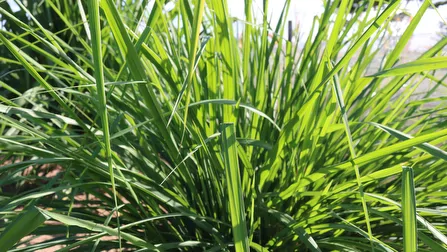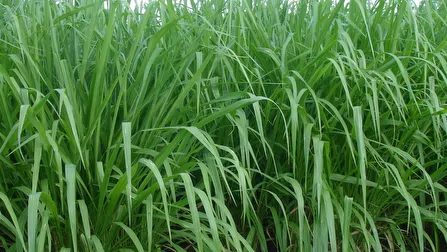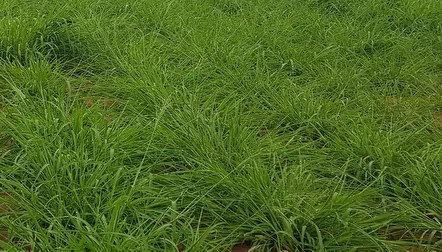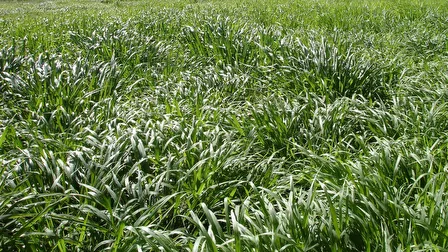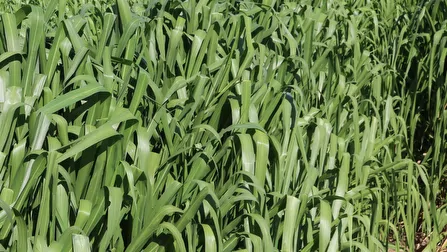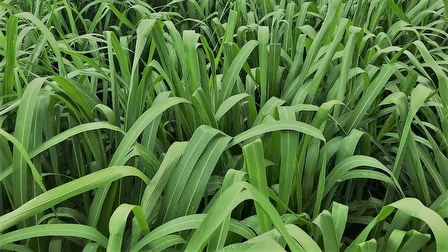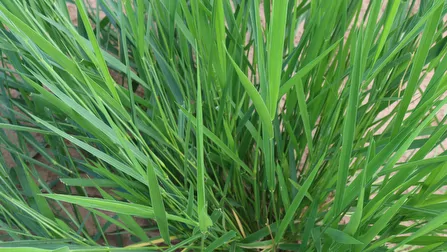
Indicação
Indicada para solo de média a baixa fertilidade, em pastejo direto pelos animais, servindo-se também para confecção de silagem e fenação, para bovino de recria e engorda e produção leiteira. Recomendamos que bezerros recém-desmamados não sejam colocados para consumir esta pastagem, pois, dependendo da região poderá apresentar problemas de fotossensibilização. Susceptível ao ataque das cigarrinhas das pastagens.
Urochloa decumbens cv. Basilisk
Brachiaria decumbens cv. Basilisk
Média a baixa fertilidade
Pastejo direto ou fenação
8 a 12 t/ha/ano de matéria seca (M.S.)
6 a 10%
0,60 a 1,00m
Boa
Boa
Alta
Susceptível
Média
Perene
Características Agronômicas
É uma planta forrageira adaptada aos solos arenosos, ácidos e até mesmo os de baixa fertilidade. Apresenta uma rápida rebrota após o pastejo. A decumbens é susceptível à cigarrinha-das-pastagens. Em regiões e áreas infestadas pelo fungo Phytomices chartarum pode provocar a requeima ou fotossensibilização pelo pastejo na decumbens, principalmente em animais mais jovens (bezerros).
Utilização e Manejo
A decumbens é uma forrageira indicada para solos de média a baixa fertilidade, bem drenados, em clima mais áridos. Pode ser utilizada também em áreas com maior declividade pois consegue fazer uma boa cobertura do solo. É recomendada em pastejo direto pelos animais, servindo-se também para confecção de silagem e fenação para bovinos de recria e engorda, e produção de leite. Possui uma boa distribuição de produção de forragem durante o ano todo. Portanto, pode ser utilizada em áreas de pastejo extensivo. O consumo dessa pastagem por bezerros recém-desmamados deve ser evitado, pois, dependendo da região poderá apresentar problemas de fotossensibilização, devido à ação do fungo Phytomices chartarum. Com um manejo adequado, evitando acúmulo de folhas mortas, através do aumento da intensidade de pastejo, podemos evitar ou diminuir a intensidade da doença. Em bezerros desmamados, devido o estresse do desmame associado à idade do animal, predispõem o aparecimento da fotossensibilização. Neste caso recomendamos a retirada dos animais da decumbens, colocando-os em áreas sombreadas de outras espécies forrageiras e o uso de dessensibilizantes auxilia na recuperação destes animais. A decumbens como uma espécie susceptível às cigarrinhas não deve ser estabelecida em regiões com histórico deste inseto.
Origem
Esta é a cultivar de forrageira, do gênero Brachiaria mais conhecida e um dos mais utilizado em todo o mundo. Esta cultivar é originário de semente (CPI 1694) introduzida da Austrália, proveniente do Departamento de Agricultura de Uganda, em 1930. Em 1973 foi liberada comercialmente na Austrália. Originário do platô dos Grandes Lagos em Uganda foi introduzido no Brasil pelo antigo IPEAN (Instituto de Pesquisa Agropecuária do Norte - atual EMBRAPA).
Características Morfológicas
Gramínea de hábito decumbente, bastante enfolhada, formando denso relvado de até 100 cm de altura. Folhas muito pubescentes e inflorescência racemosas contendo racemos com fila dupla de sementes também pubescentes, ráquilas em zigue-zague e finas. As plantas são robustas, geniculada em alguns nós inferiores e pouco radicante. Os rizomas apresentam-se na forma de pequenos nódulos e emitem grande quantidade de estolões, bem enraizados e com pontos de crescimento protegidos (rizomas e gemas axilares).
